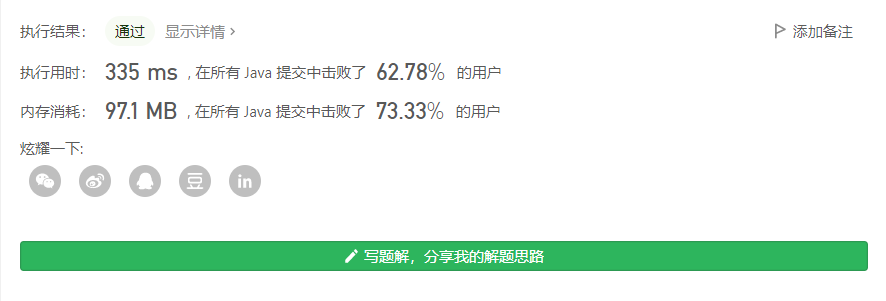题目
一个王国里住着国王、他的孩子们、他的孙子们等等。每一个时间点,这个家庭里有人出生也有人死亡。
这个王国有一个明确规定的皇位继承顺序,第一继承人总是国王自己。我们定义递归函数 Successor(x, curOrder) ,给定一个人 x 和当前的继承顺序,该函数返回 x 的下一继承人。
Successor(x, curOrder):如果 x 没有孩子或者所有 x 的孩子都在 curOrder 中:如果 x 是国王,那么返回 null否则,返回 Successor(x 的父亲, curOrder)否则,返回 x 不在 curOrder 中最年长的孩子
比方说,假设王国由国王,他的孩子 Alice 和 Bob (Alice 比 Bob 年长)和 Alice 的孩子 Jack 组成。
一开始, curOrder 为 [“king”].
调用 Successor(king, curOrder) ,返回 Alice ,所以我们将 Alice 放入 curOrder 中,得到 [“king”, “Alice”] 。
调用 Successor(Alice, curOrder) ,返回 Jack ,所以我们将 Jack 放入 curOrder 中,得到 [“king”, “Alice”, “Jack”] 。
调用 Successor(Jack, curOrder) ,返回 Bob ,所以我们将 Bob 放入 curOrder 中,得到 [“king”, “Alice”, “Jack”, “Bob”] 。
调用 Successor(Bob, curOrder) ,返回 null 。最终得到继承顺序为 [“king”, “Alice”, “Jack”, “Bob”] 。
通过以上的函数,我们总是能得到一个唯一的继承顺序。
请你实现 ThroneInheritance 类:
- ThroneInheritance(string kingName) 初始化一个 ThroneInheritance 类的对象。国王的名字作为构造函数的参数传入。
- void birth(string parentName, string childName) 表示 parentName 新拥有了一个名为 childName 的孩子。
- void death(string name) 表示名为 name 的人死亡。一个人的死亡不会影响 Successor 函数,也不会影响当前的继承顺序。你可以只将这个人标记为死亡状态。
- string[] getInheritanceOrder() 返回 除去 死亡人员的当前继承顺序列表。
示例:
输入:
["ThroneInheritance", "birth", "birth", "birth", "birth", "birth", "birth", "getInheritanceOrder", "death", "getInheritanceOrder"]
[["king"], ["king", "andy"], ["king", "bob"], ["king", "catherine"], ["andy", "matthew"], ["bob", "alex"], ["bob", "asha"], [null], ["bob"], [null]]
输出:
[null, null, null, null, null, null, null, ["king", "andy", "matthew", "bob", "alex", "asha", "catherine"], null, ["king", "andy", "matthew", "alex", "asha", "catherine"]]解释:
ThroneInheritance t= new ThroneInheritance("king"); // 继承顺序:king
t.birth("king", "andy"); // 继承顺序:king > andy
t.birth("king", "bob"); // 继承顺序:king > andy > bob
t.birth("king", "catherine"); // 继承顺序:king > andy > bob > catherine
t.birth("andy", "matthew"); // 继承顺序:king > andy > matthew > bob > catherine
t.birth("bob", "alex"); // 继承顺序:king > andy > matthew > bob > alex > catherine
t.birth("bob", "asha"); // 继承顺序:king > andy > matthew > bob > alex > asha > catherine
t.getInheritanceOrder(); // 返回 ["king", "andy", "matthew", "bob", "alex", "asha", "catherine"]
t.death("bob"); // 继承顺序:king > andy > matthew > bob(已经去世)> alex > asha > catherine
t.getInheritanceOrder(); // 返回 ["king", "andy", "matthew", "alex", "asha", "catherine"]
提示:
- 1 <= kingName.length, parentName.length, childName.length, name.length <= 15
- kingName,parentName, childName 和 name 仅包含小写英文字母。
- 所有的参数 childName 和 kingName 互不相同。
- 所有 death 函数中的死亡名字 name 要么是国王,要么是已经出生了的人员名字。
- 每次调用 birth(parentName, childName) 时,测试用例都保证 parentName 对应的人员是活着的。
- 最多调用 105 次birth 和 death 。
- 最多调用 10 次 getInheritanceOrder 。

解题思路
通过map和list组合,key记录人名,value记录孩子名字,这样就构造出一个具有层级结构的表示继承关系的多层树,根节点是国王,因为list的遍历次序就是插入次序,因此使用深度优先搜索遍历的顺序,就是继承关系。使用set维护去世的人名,避免加入到结果中去。
代码
class ThroneInheritance {Map<String,List<String>> map=new HashMap<>();Set<String> death=new HashSet<>();String king;public ThroneInheritance(String kingName) {king=kingName;map.put(kingName,new ArrayList<>());}public void birth(String parentName, String childName) {if(!map.containsKey(parentName))map.put(parentName,new ArrayList<>());map.get(parentName).add(childName);}public void death(String name) {death.add(name);}public void dfs(List<String> res,String cur){if(!death.contains(cur)) res.add(cur);if(map.containsKey(cur)){for (String s : map.get(cur)) {dfs(res,s);}}}public List<String> getInheritanceOrder() {ArrayList<String> res = new ArrayList<>();dfs(res,king);return res;}}
/*** Your ThroneInheritance object will be instantiated and called as such:* ThroneInheritance obj = new ThroneInheritance(kingName);* obj.birth(parentName,childName);* obj.death(name);* List<String> param_3 = obj.getInheritanceOrder();*/






)


)




![[转]kafka介绍](http://pic.xiahunao.cn/[转]kafka介绍)




